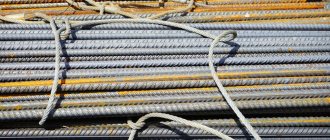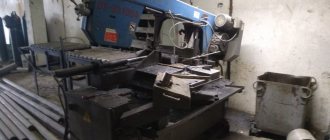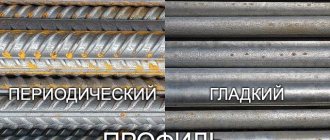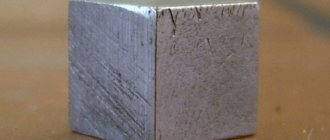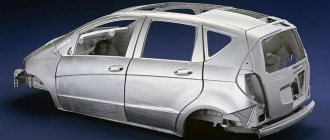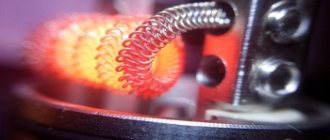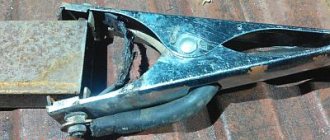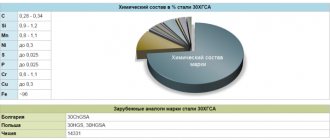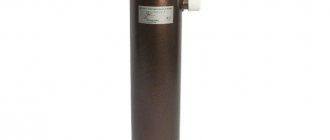Features of fiberglass structure
Polymer composite reinforcement has a couple of main parts:
- ⦁ the inner rod is made of fiberglass fibers arranged parallel to each other. The fibers are bound together by a special polymer resin composition. There are options when manufacturers offer reinforcement in which the intra-rod fiber is twisted in the shape of a pigtail. It is important to note that it is this internal rod of fiberglass reinforcement that determines its initial characteristics and is responsible for strength.
- ⦁ the outer layer of the reinforcing rod is made using the type of bidirectional wrapping from fibers of a composite material. Often there are products in which the top layer is made using spraying of fine abrasive powder.
The technical production of fiberglass reinforcement bars is determined by the capabilities, equipment and imagination of the manufacturers. As well as manufacturing technologies for this material, on which the final quality of the product will depend.
Solutions
Fiberglass reinforcement for the pond frame Fiberglass reinforcement “SZS” was used to make the frame for the pond bowl in the “Dachny Otvet” program. Fiberglass reinforcement for the parking lot foundation During the construction of the “Garden with Moonlight,” the Dachny Otveta team used fiberglass reinforcement from SZS to reinforce the foundation under the parking area. Fiberglass reinforcement for the foundation of a greenhouse During the construction of the “radiant garden” by the “Dachny Otvet” program, fiberglass reinforcement from SZS was used to strengthen the foundation of the greenhouse. Fiberglass reinforcement for the terrace foundation When constructing a patio with a moon window, fiberglass reinforcement from SZS was used as a frame for the terrace foundation.
Advantages of composite reinforcement
Fittings made of fiberglass periodically undergo numerous inspections, trials and tests, which demonstrate its rational use, taking into account a number of characteristics. Each time, the data confirms the advantageous difference from other materials of similar purpose.
It is worth considering the advantages of composite reinforcement in more detail:
- Reinforcement bars made of fiberglass are light in weight. The weight of composite reinforcement is up to 9 times less than that of similar metal products;
- In a comparative analysis of corrosion resistance, fiberglass reinforcement is 10 times more reliable than steel reinforcement with similar data. The consumer appreciates the excellent resistance of this material to aggressive environments, such as salty, alkaline or acidic;
- Composite reinforcement conducts heat much less than metal reinforcement, therefore the occurrence of “cold bridges” is minimized;
- In many cases, purchasing composite reinforcement is much more profitable in financial terms - transportation, unloading and longer service life are much more convenient;
- The invaluable advantages of composite reinforcement also lie in its transparency for electromagnetic waves and impediment to electric current;
- It greatly simplifies the work of installing structures - there is no need to purchase equipment for welding and tools for cutting metal;
Possible sizes of composite reinforcement
We have already pointed out that the dimensions of composite reinforcement can vary depending on the capabilities of the manufacturer.
Also, often this type of fittings is made individually, taking into account the specific requirements of the customer.
Here are the most common sizes of composite reinforcement in demand in the construction market:
- Reinforcement in which the diameter of the rod is from 4.6 to 8 mm is wound into coils, the diameter of the coils themselves is no more than 1 meter;
- A coil of fiberglass reinforcement, which has a diameter of 10 mm, also has a diameter of about 1 meter;
- Reinforcement produced with a bar cross-section of 12 mm is produced and stored in coils whose diameter reaches 1.5 m;
Comparative table of parameters of reinforcement made of different materials
| Diameter of fiberglass reinforcement ASP | 4 mm | 6 mm | 8 mm | 10 mm | 12 mm | 14 mm | 16 mm | 18 mm | 20 mm |
| Diameter of equivalent steel reinforcement | 6 mm | 8 mm | 12 mm | 14 mm | 16 mm | 18 mm | 20 mm | 22 mm | 25 mm |
| Weight of 1 meter ASP, kg | 0,030 | 0,060 | 0,083 | 0,135 | 0,210 | 0240 | 0,287 | 0,313 | 0,353 |
| Weight of 1 meter of steel reinforcement, kg | 0,222 | 0,395 | 0,888 | 1,210 | 1,580 | 2,000 | 2,470 | 2,980 | 3,850 |
| Footage of 1 ton of ASP, m | 33334 | 16667 | 12048 | 7407 | 4762 | 4167 | 3484 | 3195 | 2833 |
| Meterage of 1 ton of steel reinforcement, m | 4504 | 2532 | 1126 | 826 | 633 | 500 | 404 | 335 | 260 |
| Weight of ASP reinforcement, equivalent to 1 ton of steel, kg | 135 | 152 | 93,5 | 111,5 | 133 | 120 | 116 | 105 | 92 |
Areas of use of composite reinforcement
Taking into account the largely unique operational characteristics, composite reinforcement can be used in a wide range of construction of various building structures. As well as in the repair of buildings and infrastructure.
The following are the most frequently requested areas where the use of composite reinforcement has proven to be most effective:
- If there is no need for prestressing reinforcement and the structure is not multi-story, then it is advisable to use composite reinforcement in the installation of structures of buildings of various types - civil, industrial or residential;
- If there is a threat of electrochemical corrosion created by the influence of stray current, it is reasonable to make certain parts of structures from composite fiberglass reinforcement;
- It is possible to use this type of reinforcement to strengthen the soil during tunneling during mining;
- During the process of repairing a reinforced concrete structure, in a situation where it is impossible to apply a significant layer of mortar;
- For the purpose of installing transverse connecting connections in buildings where the walls are built from various types of building materials. These are most often combinations of gas silicate block and brick, as well as brick and concrete;
- If layered masonry is provided using small-sized elements with flexible connections, as an option it is possible to strengthen the banks of the reservoir with such a reinforcing mesh filled with pebbles or crushed stone;
- In buildings that are particularly strongly affected by an aggressive environment - building foundations, structural parts of chemical and food production buildings and agricultural facilities;
- When strengthening the base for building structures of various types;
- Private low-rise housing construction;
- During road construction, the road surface is reinforced;
- During the construction and strengthening of slopes and embankments;
- To strengthen different parts of the road, such as asphalt concrete and rails;
- Reinforcement of bridges and other spans, such as viaducts;
Vulnerabilities of composite reinforcement
Absolutely every building material, along with proven advantages, also has so-called “weaknesses”.
Composite fiberglass reinforcement also has some disadvantages. They must be taken into account at the design stage of reinforced concrete structures:
- The elastic modulus of this material is low - for example, compared to steel, it is almost 4 times inferior. This negatively affects the performance of fiberglass reinforcement during tension;
- The material is brittle and non-plastic, so changing the shape of the rod rod is problematic without heating. This determines the inconvenience in the process of manufacturing embedded parts and hinges for installation;
- Weakly resistant to high temperatures - strength characteristics are lost even when heated to about 200 degrees;
In general, if we correctly approach the use of composite fiberglass reinforcement, we have a fairly cheap, easy-to-use and reliable material for use in construction.
Fiberglass reinforcement - types and properties Fiberglass reinforcement has been used in construction since the last century, but its active use began not so long ago. All types of composite reinforcement can be seen in GOST 31938-2012 - “Composite polymer reinforcement for reinforcing concrete structures. General technical conditions". But at a given moment in time, certain types of it are most often used in construction work.
The types are as follows:
- ASK – fiberglass composite reinforcement;
- ASP - fiberglass polymer reinforcement;
- AUK – carbon composite reinforcement;
- AKK – combined composite reinforcement.
Available in the following forms:
- whips. Diameter from 4 to 12mm, any length (can be cut according to customer's request);
- bays. Diameter from 4 to 12mm, length from 30 to 100m. (winding can be different, at the request of the customer)
If we talk about the advantages of this fittings, they are as follows:
- Light weight (5-8 times less than steel reinforcement of the same diameter), which makes it easier to both work with the reinforcement and transport it.
- Low thermal conductivity (almost 100 times lower than that of steel), which reduces the heat loss of a concrete structure reinforced with composite rods.
- Environmentally friendly - does not emit toxic substances.
- Radio transparency - does not interfere with radio waves or cellular communications.
- The durability of fiberglass is 50-80 years.
- Absolute corrosion resistance.
- The tensile strength is 2-2.5 times greater than that of metal.
- Can be operated in a temperature range from -70 to +200 degrees.
- Reinforcement is done without welding - the glass composite is simply tied together with wire or plastic clamps.
- Does not conduct electric current.
- The reinforcement is sold both in the form of rods and coils, which allows you to cut it into pieces of the required length. This significantly reduces waste.
But the material also has disadvantages:
- Low strength for loads such as shear, shear, and fracture.
- The use of composite reinforcement when concreting load-bearing floor slabs is prohibited.
Composite reinforcement should be used:
Areas of application of composite reinforcement Housing and civil construction • Building foundations; • In layered masonry of brick buildings; • As dowels for fastening external thermal insulation of building walls; • As meshes and rods in structures; • In the production of thermally efficient blocks; • When reinforcing bowls of swimming pools and fountains. Industrial construction • Reinforcement of concrete floors; • Reinforcement of grillages (the upper part of a pile or columnar foundation). Road construction • Strengthening the road and airfield; • Road slabs; • Paving slabs; • Pedestrian paths. Concrete products: • Power line supports, lighting poles, insulating power line cross-arms; • Road and sidewalk slabs, fence slabs, curbs, posts, etc.; • Railway sleepers; • Shaped products for collectors, utility systems; • Concrete tanks and storage facilities for wastewater treatment plants and chemical production facilities, chemical production infrastructure.
- for the construction of special structures where dielectric properties and radio transparency are important
- The use of non-metallic reinforcement increases the service life of structures by 2-3 times compared to the use of metal reinforcement, especially when exposed to aggressive environments, including those containing chloride salts, alkalis and acids.
Price list
from 06/21/2021
For fiberglass reinforcement without delivery costs.
| Diameter of composite (fiberglass) reinforcement | Quality | Footage |
linear meter weight
up to 2km Wholesale
price per linear meter up to 5 km Dealer price per linear meter or
over 5 km 4 GOST
31938-2012 50/100 1.05x1.05x0.03m/
0.02kg 12 12 12 TU 50/100 1.05x1.05x0.03m/
0.018kg 10.00 10.00 10.00 6 GOST
31938-2012 50/100 1.05x1.05x0.05m/
0.06kg 20.00 20.00 20.00 TU 50/100 1.05x1.05x0.05m/
0.018kg 18.00 18.00 18.00 8 GOST
31938-2012 50/100 1.05x1.05x0.07m/
0.085kg 30.00 30.00 30.00 TU 50/100 1.05x1.05x0.07m/
0.018kg 28.00 28.00 28.00 10 GOST
31938-2012 50/100 1.05x1.05x0.1m/
0.12kg 42.00 42.00 42.00 TU 50/100 1.05x1.05x0.1m/
0.018kg 40.00 40.00 40.00 12 GOST
31938-2012 50 1.2x1.2x0.12m/
0.2kg 56.00 56.00 56.00 TU 50 1.2x1.2x0.12m/
0.018kg 54,00 54,00 54,00
